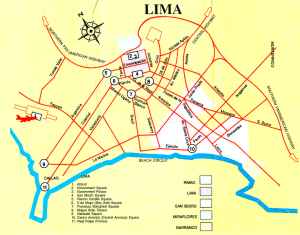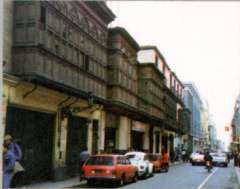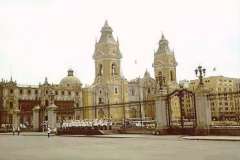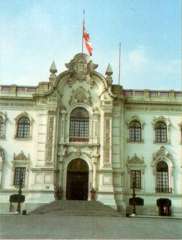LOCATION
|
Lima, the capital of Peru, is located on the west central coast of South America, 150 m/427 ft.a.s.l. Climate: Seasons are opposite to those of the United States and Europe. Summer is from December through April. The average temperature is between 25ºC in summer and 15ºC in winter. |
BRIEF HISTORY
PRE-COLUMBIAN PERIOD:
In the very ancient times, there was a fishermen village in the area, whose inhabitants were essentially religious. Later on, the Proto-Lima culture appeared comprising two expressions: the Maranga and the Aramburu.
The cultures in the Lima valley were developed by three people: the Collas coming from Canta and Huarochiri, the Huanchos who came following the course of the Rimac river, and the Huallas who entered the valley through Carabayllo.
When the Incas arrived, they respected their buildings, way of living and religion, allowing them to worship the new God Pachacarnac along with their own god the Sun.
|
HISPANIC PERIOD: |
|
|
During this period of 282 years, religious life ‘flourished. This being the time of Santa Rosa of Lima, Patron Saint of Peru, America and the Philippines, the world known San Martin de Porras, Patron Saint of barbers and hairdressers, and also San Juan Masias. |
REPUBLICAN PERIOD:
General Jose de San Martin, proclaimed the independence of Peru in Lima on July 28, 1821.
It was later, during the government of Mariscal Ramon Castilla, that Lima took an advanced step over the cities of the American continent by implementing a railroad for the first time in South America between the cities of Lima and Callao. It was also during this period that gaslight and the telegraph were installed and black slavery was abolished.
TOURIST ATTRACTIONS
PLAZA DE ARMAS (Main Square): It was Francisco Pizarro, the founder of Lima who determined the area for the square, as well as the location for the Government House (now Government Palace), the Cathedral and the Cabildo (Town Hall). Today, this square continues to occupy the same original area, in the middle of which there is a splendid bronze fountain dating back to 1650.
|
|
THE CATHEDRAL: It was initially devoted to Our Lady of Assumption. Almost entirely destroyed during the 1746 earthquake, the Viceroy Jose Antonio Manso de Velasco Conde de Superunda had it rebuilt in 1758. Its interior is remarkable for the intricate carving work of the wooden seats of the choir, the heavily ornamented “Inmaculada” chapel of baroque style and an ivory Christ carved by Martinez Montañez, a splendid gift from King Charles V Entering the church and to the fight there is a chapel which holds the remains of the conqueror Francisco Pizarro. In the sacristy there is a museum of religious art. |
|
GOVERNMENT PALACE: Also known as the House of Pizarro because since the foundation of Lima, this was the place where the conqueror worked and lived until his death in 1541. It has magnificent halls such as the Salon Dorado where important paintings are exhibited. It also has an elegant area which is the official residence of the President of Peru. It is recommended to attend the change of guard which takes place daily at 11:45 am. at the front esplanade
|
|
SANTO DOMINGO CHURCH AND MONASTERY: (Comer of Conde de Superunda and Camana Streets). Dates from the end of the l6th century. On the left, the Virgin of the Rosary is venerated. To the fight there is an altar for Peruvian saints: Santa Rosa de Lima, San Martin de Porras and San Juan Masias. Under each of the images there is a silver urn containing relics of these saints. The tower of the church is of a singular architectural style, and the monastery is one of the best preserved in Lima.
SAN PEDRO CHURCH: (Comer of Azangaro and Ucayali Streets) This church was built by the Jesuits in 1624. Its side aisles are notable for their arcades and gold-leaf-covered altars of baroque style. Specially remarkable are the altars of San Ignacio de Loyola and Santa Lucia. The church houses numerous colonial paintings and has a laboriously carved stone portico.
SAN FRANCISCO CHURCH: (Ancash Street, 2nd block) This colonial architectural complex includes the monastery, the church of San Francisco and the chapels of La Soledad and El Milagro. The monastery, cloisters and entrance hall are embelished with authentic Sevillian tiles dating back to 1620. Also remarkable are its Museum of Religious Art, the Zurbaran room and the library. The complex was built over underground galleries or catacombs which were used as cemeteries during the colony. These can be visited.
LA MERCED CHURCH: Jiron de la Union Street 6th block) This church has a notable stone portico (18th century). Its main altar renders homage to the Virgin of the Mercies, Patron Saint of the Armed Forces of Peru and who holds the tide of Mariscala (marshal). In the fight aisle, the Cruz del Padre Urraca (Padre Urraca’s Cross) is venerated because of his many miracles.
JESUS MARIA CHURCH: (Comer of Moquegua and Camana Streets) Single aisle church with magnificent altars carved on wood covered with gold leaf and baroque style pulpit.
SANTA ROSA CHURCH AND SANCTUARY: (Tacna Avenue, I st block) The church was built upon the place where Isabel Flores de Oliva, Santa Rosa de Lima, was born (1586). It keeps its relics and the famous doctorcito or image of the Christ Child who is believed to have assisted her when taking care of the sick people. In the garden are the hermitage that she built with her brother and the well in which the saint dropped the key of the lock of her penitence waist chain.
THE NAZARENAS CHURCH AND CONVENT: (Comer of Huancavelica. Street and Tacna Avenue). Built during the colony upon the place that used to be the quarter of Pachacamilla, a place inhabited by descendants of black slaves brought from Angola who had conformed a confraternity. It is said that one of them painted an image of Christ on the Cross upon a wall. This wall remained unharmed in spite of a severe earthquake (1655). It was since then that cult and devotion to the image have considerably increased. A replica of the painting, was made and it is carried throughout the city, every October (I 8th, I 9th and 28th), in impressive processions. The image is known as Señor de los Milagros (Lord of the Miracles), Cristo Morado (Christ in Purple) or Cristo de los Teniblores (Christ of the Earthquakes) and is considered the Patron Saint of Lima.
SAN SEBASTIAN CHURCH: (Ica Street, 5th block) This church dates back to 1544 and was the first parish in Lima. It was here that Santa Rosa de Lima, San Martin de Pon-as, Jose Santos Chocano and Francisco Bolognesi, among other prominent Peruvians, were baptized. It has been recently restored.
SAN AGUSTIN CHURCH: (Comer of Ica and Camana Streets) It was built in the 19th century. Of its original structure remains the baroquestile portico, the sacristy with carvings in wood and in the foreroom, a beautiftily carved ceiling, a tile skirting and also an impressive wooden sculpture of La Muerte (Death) by Baltazar Gavilan
SAN MARCELO CHURCH: (Comer of Rufino Torrico Street and Emancipacion Avenue) It was founded by the Augustinian congregation during the middle of the 16th century. Its facade has expressions of baroque style.
PACHACAMAC was an important religious centre before the arrival of Spanish conquistadors
MUSEUMS
NATIONAL MUSEUM OF ANTHROPOLOGY, ARCHAEOLO_ GY AND HISTORY. Plaza Bolivar in the district of Pueblo Libre. Phone (51-1) 463-5070. Visits: Tuesday to Saturday from 9 am to 5:45 pm. Sundays, from 9 am to 4:45 pm.
Evidence of all cultures in the Peruvian civilization are exhibited in a chronological and didactic way, being the most interesting the collections of Chavin, Paracas, Nasca, Mochica, Huari, Chimu, and Inca.
Paintings, objects, documents and relics of the colony, emancipation, independence process and republican period are exhibited in the adjoining manor house, which was the residence of the viceroys Pezuela and La Sema and Peru’s libertadores San Martin and Bolivar
GOLD OF PERU MUSEUM: Alonso de Molina Street 1100 in the district of Monterrico. Phone (51-1) 435-2917. Daily visits from 12 am to 7 pm.
Exhibition of thousands of gold pieces such as necklaces, funerary masks, scepters, ceremonial cups, tumis (sacrificial knives), nose rings, earrings and idols, which show how advanced were the gold and silver works in ancient Peru. There is also a large collection of weaponry from. different parts of the world.
RAFAEL LARCO HERRERA ARCHAEOLOGICAL MUSEUM: Bolivar Avenue 1515 in the district of Pueblo Libre. Phone (51-1) 461-1312 / 461-1835. Visits: Monday to Saturday from 9 am to 6 pm. Sundays from 9 am to 1 pm.
Interesting collection of ceramics, textiles and gold and silver work, specially from the northern civilizations. There is also a room with erotic ceramics and a vault containing pieces of gold and jewelry.
MUSEO DE LA NACION: (East Javier Prado Avenue 2465 in the district of San BorJa. Phone (51-1) 476-9875 / 476-9901. Visits: Tuesday to Sundays from 9 am to 6 pm.
The most important aspects in the development of ancient Peru are presented in impressive halls. There are also replicas of archaeological sites, engravings and dioramas.
AMANO MUSEUM: Retiro Street 160 in the district of Miraflores. Phone (51-1) 442-2909. Visits are subject to previous telephone appointment
Private collection of Mr. Yoshitaro Amano exhibiting selected pieces of ceramics and textiles from the Chancay culture.
ART MUSEUM: Paseo Colon Avenue 125. Phone (51-1) 423-4732. Visits: Tuesday to Sunday from 9 am to 5 pm.
Panoramic exhibition of Peruvian culture: pre-Columbian ceramics and textiles, colonial furniture and silverware, costumes and tapad~s (veiled women) and also paintings from the Cusco School, as well as from the Republican and Contemporary periods.
BANCO CENTRAL DE RESERVA MUSEUM: Comer of Lampa. and Ucayali Streets. Phone (51-1) 427-6250. Visits: Tuesday to Friday from 10 am to 4:30 pm. Saturdays and Sundays from 10 am to 1pm.
Pre-Columbian ceramics, coins and paintings, among other collection pieces.
SAN FRANCISCO DE JESUS MUSEUM: Ancash Street, 3rd Nock Daily visits from 10 am to 5:45 pm.
Liturgical pieces from the colonial period, carvings and paintings by Zurbaran.
MUSEUM OF THE CONGRESS AND THE INQUISITION: Plaza del Congreso Square, also known as Plaza Bolivar and Plaza de ]a Inquisicion. Phone (51-1) 427-0365. Visits: Monday to Friday: 9 am to I pm. and 2 to 6 pm. Saturdays: from 9 am to 1pm.
The audience chamber has a splendid carved ceiling. The original cells show inscriptions made by the prisoners. There are also on-the-site reproductions of the punishments inflicted by order of the Holy Office Tribunal.
MUSEUM OF PERUVIAN CULTURE: Alfonso Ugarte Avenue 650. Phone (51-1) 423-5892. Visits: Tuesday to Friday from 10 am to 2:30 pm. Saturdays from 10 am to 2:30 pm.
Exhibition of Peruvian popular art (ceramics, textiles, leather work and religious images).
JAVIER PRADO MUSEUM OF NATURAL HISTORY OF THE SAN MARCOS MAJOR UNIVERSITY
Arenales Avenue 1256 in the district of Lince. Phone (51-1) 471-0117. Visits: Monday to Saturday from 9 to 12 am. Sundays from 9 am to 1pm.
Collection of Peruvian flora and fauna specimen and minerals, started by Italian investigator Antonio Raimondi. Interesting dioramas.
MUSEUM OF ITALIAN ART: Pasco de la Republica Avenue, 2nd block – Parque Neptuno. Phone (51-1) 423-9932. Visits: Monday to Friday from 9 am to 2:30 pm.
Italian works of art from the last and present centuries. Temporary expositions are regularly held.
CONVENTO DE LOS DESCALZOS MUSEUM:
Alameda de Jos Descalzos 202 in the district of Rimac. Phone (51-1) 481-044 1. Visits: Thursday to Monday: 9:30 am to I pm. and 3 to 6 pm.
Valuable colonial paintings and religious objects.
CATHEDRAL MUSEUM OF RELIGIOUS ART: Main Square. Phone (51-1) 427-5980. Visits: Monday to Friday: 10 to 12:45 am. and 2 to 4:45 pm.
Carvings, ornaments, paintings, furniture and liturgical objects from the colonial period.
MUSEUMS IN THE MAIN QUARTERS OF THE SAN MARCOS MAJOR UNIVERSITY: (Parque Universitano)
ARCHAEOLOGICAL AND ETHNOLOGICAL MUSEUM: Phone (51-1) 428-0052. Visits: Monday to Saturday from 8 am to 2 pm.
Exhibition of the Chavin collection as well as the latest archaeological findings made by the University. There is also a collection of interesting pre-Columbian musical instruments.
ART AND HISTORY MUSEUM: Phone (51-1) 427-4870. Visits: Monday to Saturday from 9 am to 2 pm. Colonial paintings, books, furniture, documents and Peruvian popular art.
BULLFIGHTING MUSEUM: Hualgayoc Street 332 in the district of Rimac – Plaza de Acho.
Paintings, costurnes, troomes and pictures of the most renowned bullfighters .
MANSIONS
PALACIO DE TORRE TAGLE: (Ucayali Street, 3rd block)
Present headquarters of the Peruvian Ministry of Foreign Affairs. This mansion dates back to the early 18th century. Its main particularity is the inspiration of the Sevillian, Mudejar and criollo styles in its architecture. It has a stone portico and two carved balconies, considered the most beautiful in Lima.
CASA DE PILATOS: (Ancash Street 390)
Present headquarters of the National Cultural Institute. Dating back to the 16th century, it has stone columns and a monumental stairway facing the front door.
CASA ALIAGA: (Jiron de la Union Street 224)
When founding Lima (1535), Francisco Pizarro awarded to conqueror Jeronimo de Aliaga a piece of land owned by curaca Tauli Chusco (main authority in the Rimac valley) which served as a pre-Columbian adoratorium. Upon this land the conqueror built this mansion in which his descendants have lived since then. An unsual case in America.
CASA DE LAS TRECE MONEDAS: (Ancash Street 536)
Its name means The House of the Thirteen Coins. This single-storey residence dating back to mid 18th century still preserves its original architectural elements.
CASA DE LA RIVA: (Ica Street, 426)
An 18th century building. Now headquarters of the “Entre Nous” Cultural Association.
CASA DE OQUENDO OR PALACIO DE OSAMBELA: (Conde de Superunda Street 298)
Finished in 1807, this mansion has five balconies and a mirador from which the first owner of the place, Don Martin de Osambela watched with a spyglass the arrival of galleons to the port in Callao.
CASA DE LA RIVA AGUERO: (Camana Street 459). Eighteen century splendid mansion in which the Riva Aguero Institute, and the Center for Humanistic Studies of the Universidad Catolica, have their premises today. It also houses the Popular Tradition and Art Museum, with its selected exhibition of popular Peruvian art donated by private collectors, the best of which are its masks and religious images.



